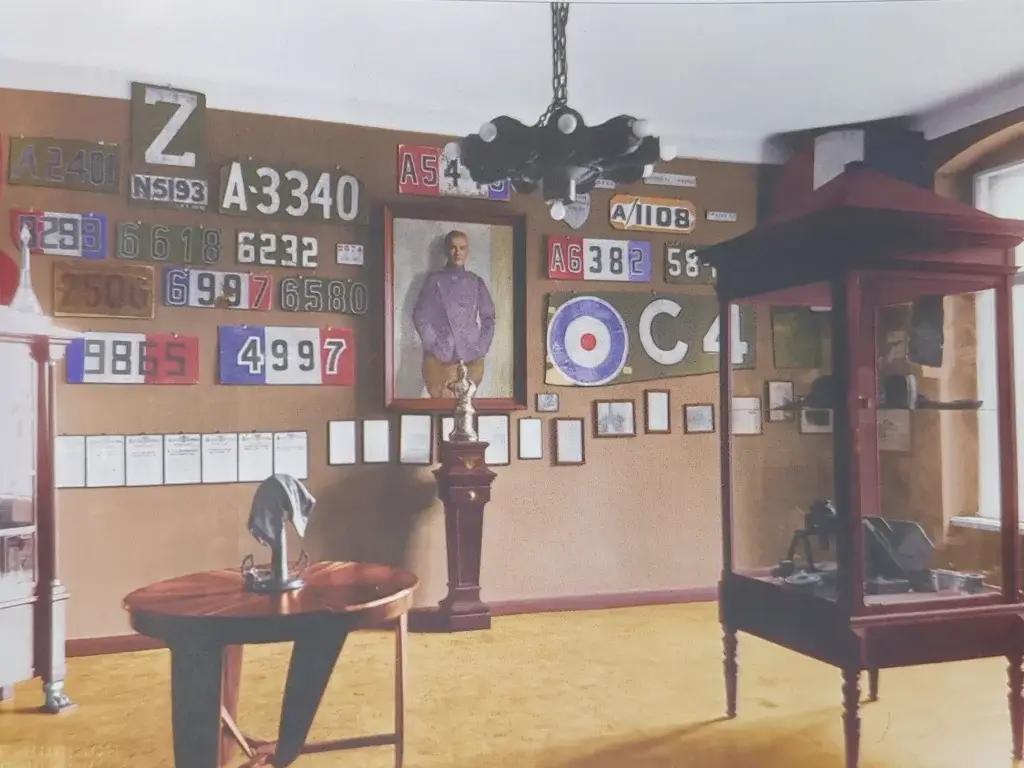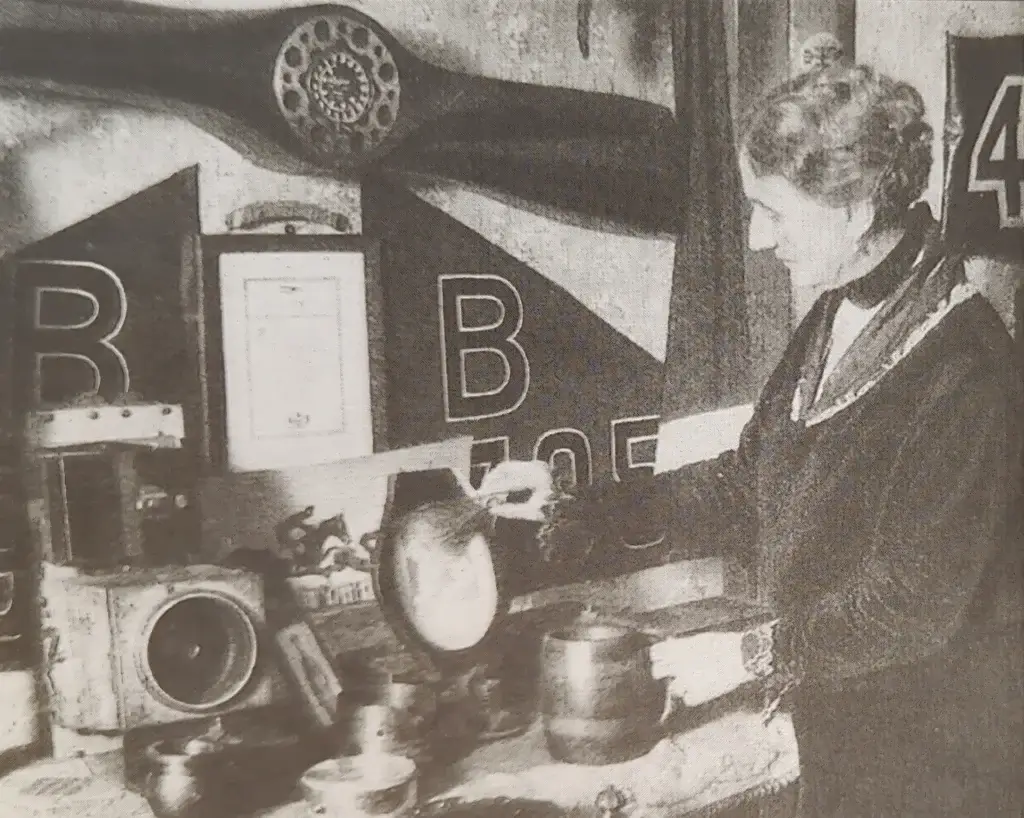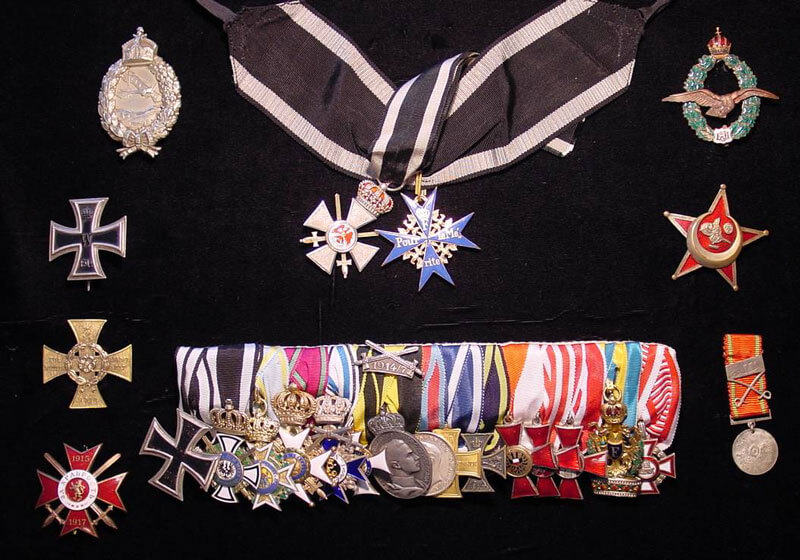A visit to the Richthofen Museum in Schweidnitz
Event ID: 622
Categories:
01 January 1938
Source ID: 54
“However, anyone travelling eastwards to Schweidnitz, the birthplace of Manfred von Richthofen, should visit the Richthofen Museum, which has been set up in his parents’ house, to complete their picture of the hero’s life and death with the help of the many valuable memorabilia on display.
The Richthofen family home is located just outside the small Silesian garrison town, which was once a Frederickian fortress. First, you have to walk through a few long streets, cross a railway line and pass a small park, whose main attraction is a dignified monument to the town’s famous son. Then you come to the street named after the hero, and at the end of it you reach Manfred’s parents’ house, a large, brightly painted villa standing in a garden, particularly striking for its tower room.
Kunigunde Freifrau von Richthofen has converted the first floor of the villa into a museum for her sons Manfred and Lothar. Six rooms and a long corridor are filled with rare treasures that are eminently worthy of one day being transferred to one of Berlin’s great imperial museums, for example the Zeughaus.
Let me now describe what there is to see here! In the stairwell, we first encounter a rich collection of antlers, an old family possession. As we heard, Manfred was an enthusiastic hunter. Many important hunters can be found among his long line of ancestors.
In the corridor on the first floor, our attention is drawn to a small picture frame, behind whose glass two bird feathers are affixed with sealing wax. In childish handwriting we read: ‘First duck, Romberg, 27 December 1906.’ So these are the first hunting trophies of the great aviator!
We also see Manfred’s Uhlan sabre and the stirrup of one of his horses, which was pierced by a grenade. The horse was killed and Manfred fell to the ground with his cloak torn to shreds.
The first room is dedicated to Lothar Freiherr von Richthofen, who ranks ninth on the list of World War I pilots with 40 kills. We stand in reverence before Lothar’s medal cushion, which displays the Pour Le Mérite among many other high orders, and before a letter written to Baroness von Richthofen by the father of Albert Ball, the best English war pilot shot down by Lothar. We marvel at a Swedish sword, the Empress’s cigarette case, the Emperor’s cufflinks – all gifts of honour to him.
We see a model of an Albatros aircraft flown by Lothar, a captured English steel helmet, two of Lothar’s propellers, a board with type plates of shot-down English aircraft and the numbers of various English aircraft defeated by Lothar. We are particularly captivated by the portrait of Lothar created by Prof. Fritz Reusing.
The second room is dedicated to his brother Manfred. It is particularly rich in exhibits. However, we can only list a few items. For example, a Biedermeier cabinet contains large and small silver cups; as is well known, Manfred gave himself such a cup as a gift for every enemy aircraft he shot down. Each of the cups bears the date of the shoot-down, the type of English aircraft and the names of the fighter pilots who witnessed it.
You can also see the cup that Manfred won when he successfully completed a cross-country ride despite a broken collarbone. Original items include a table made of propeller wood, a chandelier made from an English engine, and a bell made from an engine cylinder. There are countless English war trophies and photographs that are very valuable as documents.
The third room could be called the hunting room. Various items from Manfred’s hunting trophies hang here. The head of a bison that Manfred shot at Prince Pleß’s estate in Pleß is particularly impressive. The head of a boar shot in France and an elk shot in East Prussia are also on display here. A table made from elk feet is a curious feature.
One is moved to read a confirmation dated 27 December 1910, which reads: “The Royal Prussian Cadet Manfred Freiherr von Richthofen is hereby certified to be true that he shot 20 hares and 1 roe deer in the presence of over 100 witnesses, most of whom are of impeccable Manfred Freiherr von Richthofen is hereby certified to be true that, in the presence of over 100 witnesses, most of whom are of impeccable character, he shot and killed 20 hares and 1 pheasant (male) with his own hands today on the Jordansmühl field. The accuracy of this is certified (followed by many names).”
The fourth room is a highly interesting picture gallery. Here you will find portraits of the famous ancestors of the ‘Red Baron’, including Leopold I of Dessau, the ‘Old Dessauer’, and Margrave Karl Wilhelm Friedrich of Ansbach.
However, most of the pictures are of Manfred’s fellow aviators. We see His Excellency von Hoepnner, who was in charge of the affairs of the commanding general of the air force during the war, Colonel Thomsen, Captain Boelcke, Captain Loerzer, Captain Göring, Lieutenant Udet, Lieutenant Immelmann and so on.
With a pounding heart, one enters the adjoining fifth room. When Manfred was a boy, he lived here. Now you will find the simple black cross that adorned Manfred’s grave when he was still buried in enemy territory, in Fricourt. To the right and left of it are two evergreen shrubs. And you feel the need to lay a few fresh flowers in front of the hero’s cross.
One has to get used to the sight of the death cross in the middle of the room. However, it has a very good place here. Everything looks particularly solemn thanks to the beautiful old German war flag hanging in the background and the many ribbons dating from the day Manfred’s mortal remains were buried in Berlin’s Invalidenfriedhof cemetery.
Manfred’s medal cushion can also be found in this room. Even laymen, even young men who were not at the front, are familiar with some of the medals. But these remain a mystery to them, as they do to the old front-line soldiers. They came from Turkey, Bulgaria, Austria-Hungary or one of the 25 German states to honour the greatest German war pilot.
Above the display case with the medal cushion, you can see the zinc plate that the English attached to Manfred’s coffin as an identification mark, which consequently lay underground for eight years. Also very interesting are the airmail and the picture of Manfred’s grave in Bertangles, which were dropped by the English over the German line immediately after Manfred’s funeral.
In a small glass cabinet, you can see Manfred’s last pilot’s cap, his watch and the seat belt that held him in place when he was fatally shot.
An English medic had torn a piece of canvas from Manfred’s plane. After the war, he sent it to the hero’s mother, along with his armband and words of admiration.
The cap mentioned above was brought back from Vancouver (Canada) after the war by the commander of the cruiser ‘Karlsruhe’. A former Canadian soldier sent it to the mother, also with warm regards.
The Star-Spangled Banner kept here was laid on the hero’s grave in the Invalidenfriedhof cemetery by ocean aviators Chamberlin and Levine. All impressions are further enhanced by the pictures of the funeral by the British Royal Flying Corps in Bertangles.
Before we leave, we take a final look at the large glass cabinet, which contains Manfred’s uniforms and his thick aviator’s coat, familiar from many pictures. Recently, this highly interesting exhibition has been expanded with the opening of another room. Here, news about Manfred’s death is now collected and displayed. We find the telegrams of condolence from the Kaiser, Hindenburg and Ludendorff. We see English and French newspapers. Furthermore, there are the latest letters from former English front-line soldiers, in which they repeatedly assert that Manfred von Richthofen was not shot down from the air, but from the ground.
And everyone takes the time to study the original letter from Aviation Minister Göring, in which he informs Baroness von Richthofen that the Führer has decided to name the first fighter squadron of the new German Air Force after her unforgettable son.’






Comments (0)